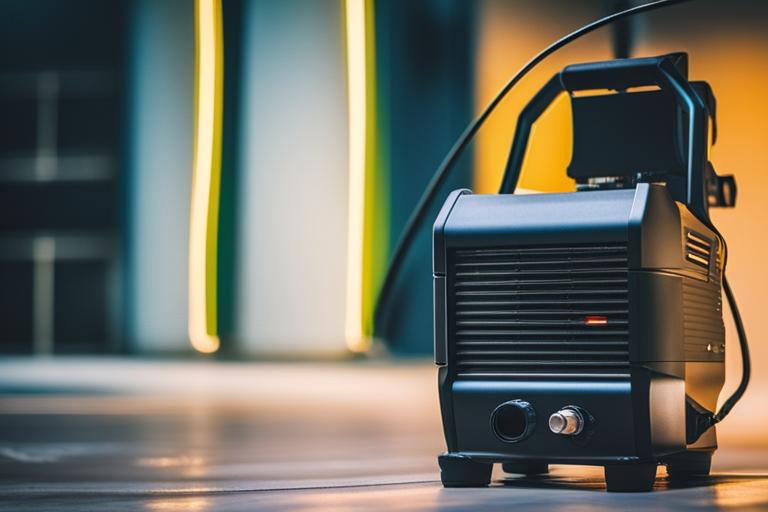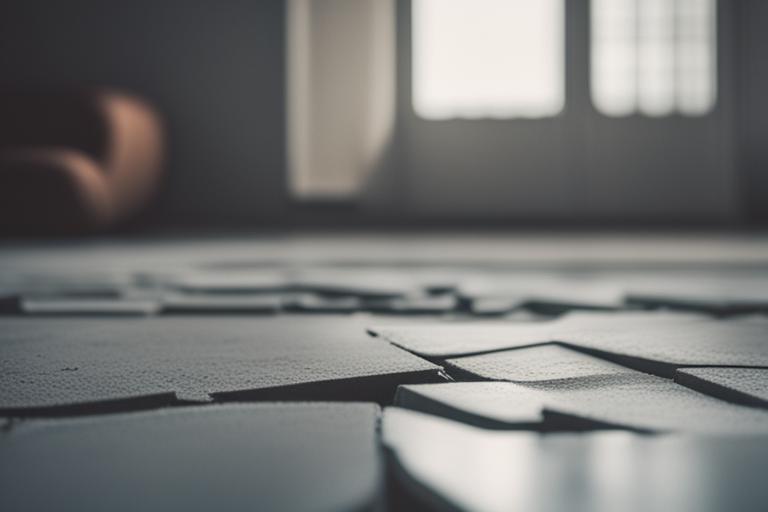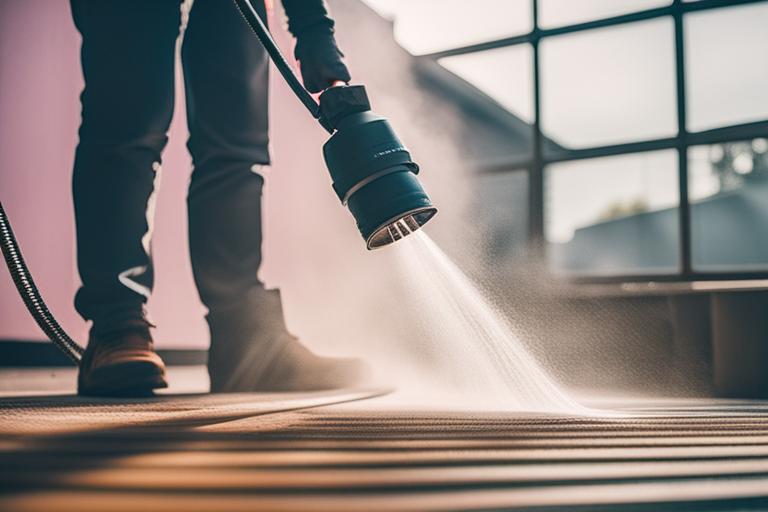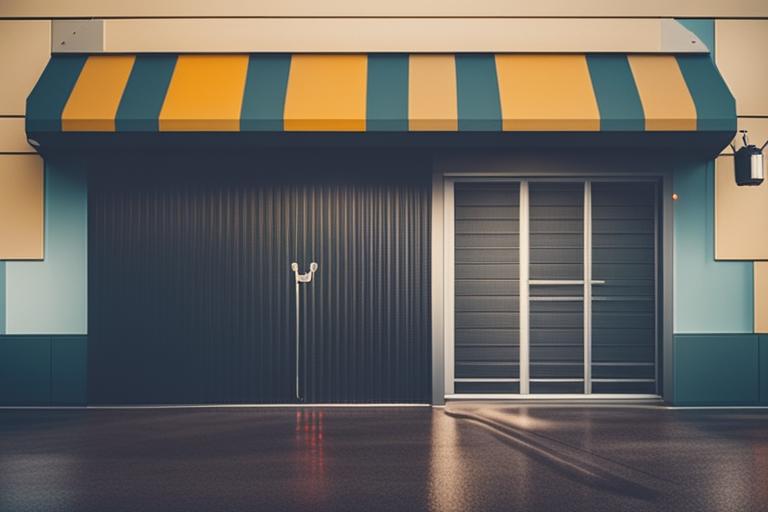Concrete is a versatile and durable material used in various applications, from building construction to outdoor patios and walkways. However, over time, concrete surfaces can become dirty and stained, making them unsightly and potentially hazardous. Power washing is a popular method used to clean concrete surfaces, but does it damage concrete? In this article, we will explore the safety and effectiveness of power washing for concrete cleaning and provide tips for effective cleaning.
Is Power Washing Safe for Concrete?
By reading this article, you will learn:
– High pressure and wrong settings can damage concrete during power washing.
– Factors like age and condition of concrete, pressure of the washer, and water temperature can contribute to concrete damage.
– Tips for preventing damage to concrete during power washing include choosing the right pressure, using the appropriate nozzle, and preparing the surface before power washing.

What is Power Washing and How Does it Work?
A. Definition of power washing
Power washing, also known as pressure washing, is a cleaning method that uses a high-pressure water stream to remove dirt, grime, stains, and other substances from various surfaces, including concrete. Power washers come in different types, including electric, gas-powered, and diesel-powered models.
B. How power washing works
Power washing works by pressurizing water and directing it through a nozzle to create a powerful stream that can remove dirt and grime from surfaces. The water pressure can be adjusted depending on the surface being cleaned. Some power washers also come with attachments that can apply cleaning solutions, which can enhance the cleaning process.
C. Types of power washers
There are different types of power washers available, including electric, gas-powered, and diesel-powered models. Electric power washers are suitable for light-duty cleaning tasks and are quieter and more lightweight than gas-powered models. Gas-powered power washers are more powerful and suitable for heavy-duty cleaning tasks. Diesel-powered power washers are the most powerful and are often used for industrial cleaning.

Understanding Concrete and Its Characteristics
A. Explanation of what concrete is
Concrete is a composite material made of cement, sand, gravel, and water. It is widely used in construction and other applications due to its strength, durability, and versatility.
B. How concrete is made
Concrete is made by mixing cement, sand, gravel, and water in a specific ratio. The mixture is poured into a form and allowed to cure, which hardens the material and gives it its strength.
C. Common concrete finishes
Concrete surfaces can have different finishes, including smooth, exposed aggregate, stamped, and polished finishes. Each finish has its unique characteristics and requires different cleaning methods.
D. Factors that affect concrete strength
The strength of concrete depends on various factors, including the quality of materials used, the water-to-cement ratio, the curing time, and the temperature and humidity during curing. Concrete that is improperly cured or exposed to harsh weather conditions can become weak and prone to damage.

How Power Washing Can Damage Concrete
A. Risks of using high pressure and wrong settings
Using high pressure or the wrong nozzle can damage concrete surfaces. The high pressure can erode the surface, causing it to become rough, pitted, or even cracked. Using the wrong nozzle can also cause damage, as some nozzles are designed for specific surfaces and pressure levels.
B. Other hazards to consider when power washing concrete
Power washing can also create hazards for the operator and the surrounding environment. The high-pressure water stream can cause injury or property damage if not used correctly. Additionally, power washing can generate wastewater that contains chemicals, dirt, and other pollutants that can harm the environment if not disposed of properly.
C. Effects of power washing on concrete surfaces
Power washing can have different effects on concrete surfaces, depending on the pressure and nozzle used. High-pressure water can remove dirt and stains, but it can also strip away the surface layer of concrete, exposing the aggregate beneath. This can create a rough and uneven surface that is more prone to damage.
Factors that Can Contribute to Concrete Damage During Power Washing
A. Age and condition of the concrete
Older and more deteriorated concrete surfaces may be more prone to damage during power washing. The surface may be weaker, and the aggregate may be more exposed, making it more susceptible to erosion and cracking.
B. Pressure of the washer
The pressure of the power washer is a critical factor in determining whether concrete surfaces will be damaged. Using too high pressure can cause the surface to become rough, pitted, or cracked.
C. Skill level of the operator
The operator’s skill level in using the power washer can also contribute to concrete damage. An inexperienced operator may use the wrong nozzle or pressure level, causing damage to the surface.
D. Water temperature
The temperature of the water used in power washing can also affect concrete surfaces. Using hot water can cause the surface to expand and contract, leading to cracking or other damage.
E. Chemicals used in the cleaning process
Some cleaning solutions used in power washing can be harsh and can damage concrete surfaces. It is essential to use the right cleaning solution for the surface being cleaned and to follow the manufacturer’s instructions.

Tips for Preventing Damage to Concrete During Power Washing
A. Choosing the right pressure for the concrete surface
Selecting the appropriate pressure for the concrete surface is crucial in preventing damage. Lower pressure is suitable for delicate surfaces, while higher pressure is best for tougher stains and grime.
B. Using the appropriate nozzle for the job
Using the right nozzle for the job is also essential in preventing damage. Nozzles that produce a wide spray pattern are suitable for cleaning large areas, while narrow spray patterns are best for removing stubborn stains.
C. Preparing the concrete surface before power washing
Preparing the concrete surface before power washing can help prevent damage. Removing loose debris and dirt and wetting the surface before power washing can help reduce the impact of the high-pressure water stream.
D. Working in sections
Working in sections can help prevent damage and ensure that the entire surface is cleaned thoroughly. It is essential to overlap each section to avoid leaving streaks or missed spots.
E. Avoiding certain areas of the concrete surface
Some areas of the concrete surface may be more sensitive than others and may require special care. Avoiding these areas or using lower pressure can help prevent damage.

Benefits of Hiring a Professional Power Washing Service to Clean Concrete Surfaces
A. Advantages of hiring professionals
Hiring a professional power washing service can offer several benefits, including experience, expertise, and equipment. Professionals are trained to handle different surfaces and can adjust their techniques to prevent damage. They also have specialized equipment that can clean surfaces more efficiently.
B. How to choose a reputable power washing service
When choosing a power washing service, it is essential to consider their experience, reputation, and credentials. Look for a company that has a proven track record of providing quality services and has the necessary licenses and insurance.
C. What to expect from a professional power washing service
A professional power washing service will inspect the concrete surface and determine the appropriate pressure, nozzle, and cleaning solution for the job. They will also take steps to protect the surrounding environment and dispose of wastewater properly.
Case Study: The Risks of Using High Pressure When Power Washing Concrete
As a homeowner, John wanted to clean his concrete driveway and patio without having to replace it. He decided to rent a power washer from his local hardware store. Without any prior experience, he began power washing his driveway at the highest pressure setting possible. After a few minutes, he realized that the surface had been damaged due to the high pressure of the water. The concrete had developed a rough texture and he had even managed to create some divots.
John’s mistake was using too high of a pressure for the concrete surface. Concrete is a porous material, and it can be easily damaged by high pressure. The high pressure of the water can cause the surface to become pitted or flaked, which can lead to more serious problems over time.
John learned that he needed to use the appropriate nozzle and the right water pressure for the job. He also learned that it was important to work in sections and not rush the process. John eventually had to hire a professional power washing service to fix the damage he had done and to clean the rest of his concrete surfaces.
This case study illustrates the importance of understanding the risks of using high pressure when power washing concrete surfaces and using the proper pressure and nozzle for the job.
Steps to Take if Concrete Damage Does Occur During Power Washing
A. Assessing the extent of the damage
If concrete damage occurs during power washing, it is essential to assess the extent of the damage. Small cracks or pits can be repaired with a concrete patch or sealant, while more extensive damage may require professional repair.
B. Considering repair options
Repairing concrete damage can be costly, so it is essential to consider all repair options. Patching or sealing may be suitable for minor damage, while resurfacing or replacement may be necessary for more extensive damage.
C. How to prevent future damage when power washing concrete
To prevent future damage when power washing concrete, it is essential to follow safety guidelines and best practices. This includes using the appropriate pressure, nozzle, and cleaning solution, as well as protecting the surrounding environment and disposing of wastewater properly.
Conclusion and Final Thoughts on the Safety and Effectiveness of Power Washing for Cleaning Concrete Surfaces
A. Summary of the article
Power washing is an effective method for cleaning concrete surfaces, but it can also cause damage if not used correctly. Factors that can contribute to concrete damage during power washing include the age and condition of the concrete, the pressure of the washer, the skill level of the operator, the water temperature, and the chemicals used in the cleaning process. To prevent damage, it is essential to choose the right pressure and nozzle, prepare the surface before power washing, work in sections, and avoid sensitive areas.
B. Does power washing damage concrete?
Power washing can damage concrete if not used correctly. High pressure and the wrong nozzle can cause the surface to become rough, pitted, or cracked. However, using the appropriate pressure and nozzle, as well as following safety guidelines and best practices, can help prevent damage.
C. Importance of following safety guidelines and best practices when power washing concrete.
Following safety guidelines and best practices is essential in preventing damage to concrete surfaces during power washing. This includes using the appropriate pressure and nozzle, preparing the surface before power washing, working in sections, avoiding sensitive areas, and protecting the surrounding environment.
D. Related questions and answers.
If you have any further questions about power washing and its effects on concrete surfaces, feel free to consult a professional power washing service or contact the manufacturer of your power washer for more information.
Follow us!!